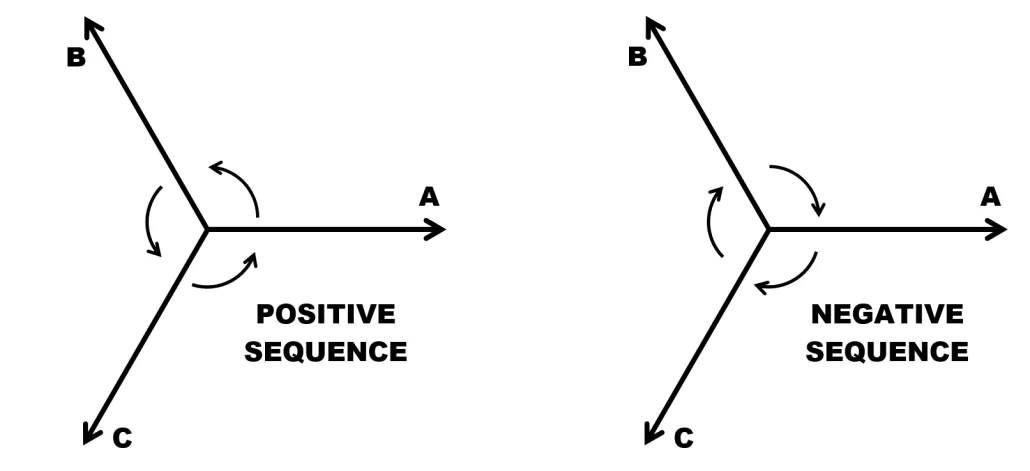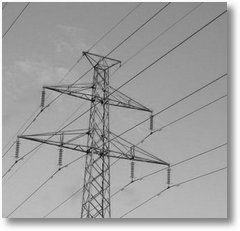What is a Negative Sequence Current?
Negative sequence current is defined as a type of unbalanced current that occurs in a three-phase electrical system. In a balanced three-phase system, the currents flowing through each phase are equal in magnitude and have a phase difference of 120 degrees. However, under certain conditions, such as faults or unbalanced loads, the currents in the three phases can become unbalanced.
Negative sequence currents is the component of unbalanced currents that has a phase sequence opposite to the normal positive sequence currents. In a positive sequence, the currents in the three phases flow in the order of phase A, phase B, and phase C. In contrast, in a negative sequence, the currents flow in the opposite order of phase C, phase B, and phase A.

Why Negative Sequence Currents Occur?
Negative sequence currents can occur due to various reasons, including unbalanced loads, faults in the system, or the presence of unbalanced impedance.
Effects of Negative Sequence Current
Negative sequence currents can have harmful effects on power system equipment and operation. The negative sequence currents can cause increased heating in motors, generators, and transformers, leading to potential damage or reduced lifespan. Negative sequence currents can also create mechanical stresses in rotating machinery, causing vibration and torque pulsations. Additionally, negative sequence currents can lead to voltage dips, unbalanced voltages, and increased power losses in the system.
Here are some of the main effects of negative sequence currents:
- Heating and Overloading
- Negative sequence currents can cause additional heating in electrical equipment such as motors, generators, and transformers. The increased heating is due to the fact that negative sequence currents produce a rotating magnetic field in the opposite direction to the normal rotation, resulting in additional losses and overheating of the equipment. This can lead to accelerated aging, reduced lifespan, and increased risk of equipment failure.
- Voltage Imbalance
- Negative sequence currents can cause voltage imbalances in the system. The presence of negative sequence components can lead to unbalanced voltages across the phases, affecting the quality and stability of the supply. Voltage imbalances can result in decreased system efficiency, increased reactive power consumption, and reduced motor performance. Furthermore, excessive voltage imbalances can lead to equipment malfunctions, flickering lights, and voltage sags or swells.
- Unwanted Torques and Vibrations
- In rotating machines such as motors and generators, negative sequence currents generate additional torques in the opposite direction to the normal rotation. These unwanted torques can cause mechanical vibrations, increased stress on bearings and shafts, and potential damage to the mechanical components of the machines.
- Loss of System Stability
- Negative sequence currents can destabilize the power system. Excessive negative sequence currents can lead to voltage instability, voltage collapse, and even system-wide blackouts. The unbalanced conditions caused by negative sequence currents can disrupt the normal operation of protective relays, voltage regulators, and control systems, potentially compromising the overall stability and reliability of the system.
- Interference with Protection Systems
- Negative sequence currents can interfere with protective relays and other protective devices. The presence of unbalanced currents can cause incorrect operation or miscoordination of protective relays, leading to ineffective fault detection and inadequate fault clearing. This can impact the overall system protection and increase the risk of prolonged outages.
Mitigation on the Effects of Negative Sequence Current
Protective relays and devices are employed to detect and mitigate the effects of negative sequence currents. These devices can monitor the magnitude and phase angle of the currents and take appropriate actions, such as tripping circuit breakers or activating alarms, to prevent further damage or mitigate the unbalanced conditions.
Some common protection measures used to mitigate the effects of negative sequence currents:
- Negative Sequence Current Protection Relays
- Protective relays specifically designed to detect and respond to negative sequence currents can be employed. These relays monitor the current flowing through each phase and compare the magnitudes and phase angles to identify unbalanced conditions. When excessive negative sequence currents are detected, the relay can trip the associated circuit breakers to isolate the fault or unbalanced condition.
- Differential Protection
- Differential protection schemes can be utilized to detect faults and unbalanced conditions caused by negative sequence currents. By comparing the currents entering and leaving a particular component, such as a motor or transformer, differential relays can identify any imbalances and initiate protective actions.
- Voltage-Based Protection
- Negative sequence currents are associated with voltage imbalances. Voltage-based protection schemes can detect and respond to abnormal voltage conditions, which can indicate the presence of negative sequence currents. Voltage relays and monitors can be utilized to monitor the voltages across the phases and activate appropriate protection measures when voltage imbalances exceed predetermined thresholds.
- Generator and Motor Protection
- Negative sequence current protection is particularly important for generators and motors, as they are most susceptible to the detrimental effects of unbalanced conditions. Generator and motor protection relays often include functions to detect negative sequence currents and initiate appropriate protective actions such as tripping the circuit breaker or reducing the output power.
- System Grounding and Neutral Protection
- Proper grounding and neutral protection measures are essential to mitigate negative sequence currents. Effective grounding practices, such as solid grounding or low-impedance grounding, can limit the propagation of negative sequence currents and reduce their effects. Additionally, neutral grounding devices like neutral grounding resistors or reactors can help detect and limit the flow of negative sequence currents during ground faults.
- System Analysis and Maintenance
- Regular system analysis, including load flow studies and fault analysis, can help identify potential sources of negative sequence currents. By understanding the system characteristics and monitoring the operation, appropriate maintenance and corrective actions can be implemented to minimize the occurrence of unbalanced conditions and negative sequence currents.
- IEC 60034-1 Rotating electrical machines - Part 1: Rating and performance
- IEC 60909-0 Short-circuit currents in three-phase a.c. systems - Part 0: Calculation of currents
- IEC 61400-27-1 Wind turbines - Part 27-1: Electrical simulation models
- IEEE 141-1993 (Red Book) Recommended Practice for Electric Power Distribution for Industrial Plants
- IEEE 519-2014 IEEE Recommended Practice and Requirements for Harmonic Control in Electric Power Systems
- IEEE C37.111-2013 IEEE Guide for the Application of Protective Relays for Transmission Line Protection
- IEEE C37.112-1996 IEEE Guide for the Application of Faulted Circuit Indicators
It is important to consult with Electrical Engineers and professionals with expertise in power system protection to design and implement effective protection schemes tailored to the specific requirements of the electrical power system.
Importance of Negative Sequence Currents
Despite the harmfull effects of negative sequence currents, it has also it advantages particularly in power system analysis and protection. Knowing the effects of negative sequence currents, the Electrical Engineer can provide mitigation measures to ensure the stable and efficient operation of electrical networks.
International Standards about Negative Sequence Currents
Reference Books for Negative Sequence Currents
- Power System Analysis by John J. Grainger and William D. Stevenson Jr
- Electrical Power Systems: Design and Analysis by Dr. Mohamed E. El-Hawary
- Power System Protection and Switchgear by Badri Ram and D.N. Vishwakarma
- Power System Harmonics and Passive Filter Designs by J.C. Das
